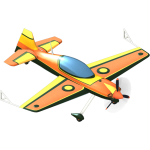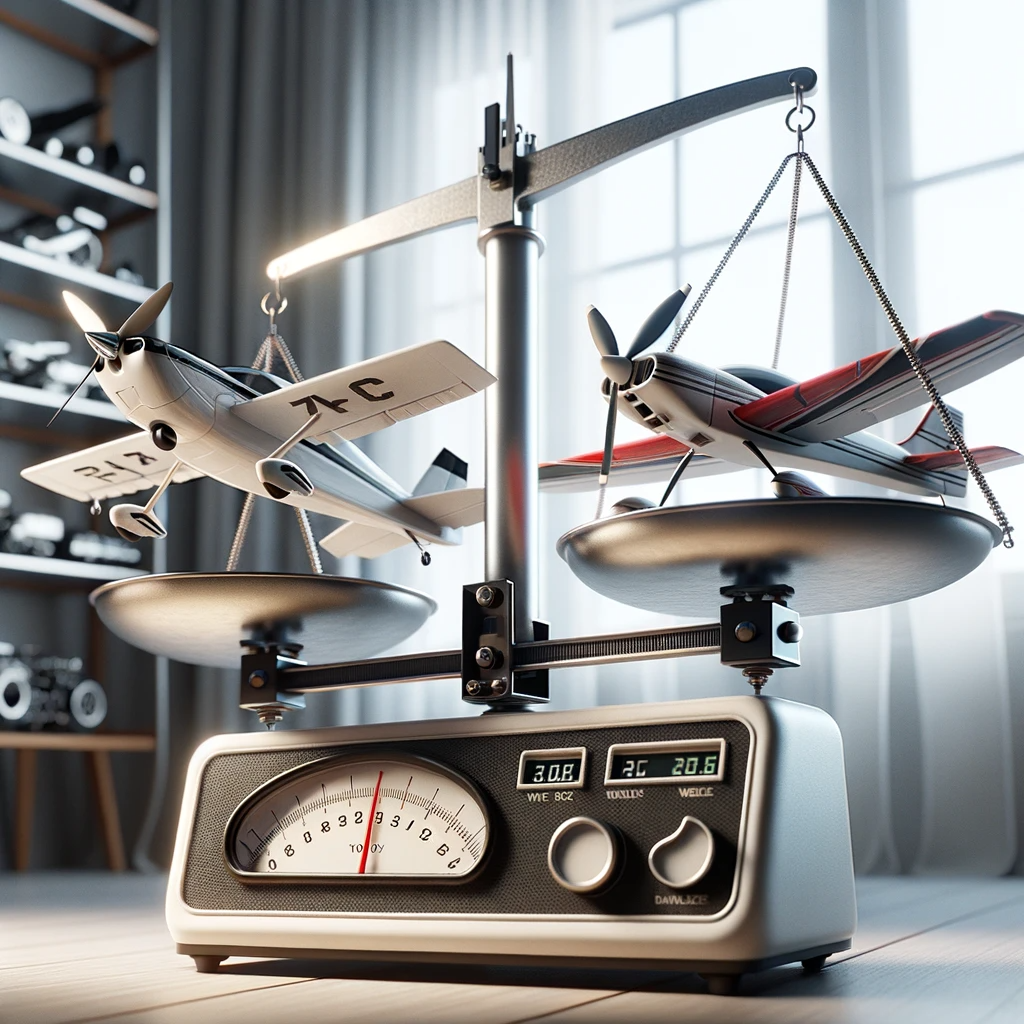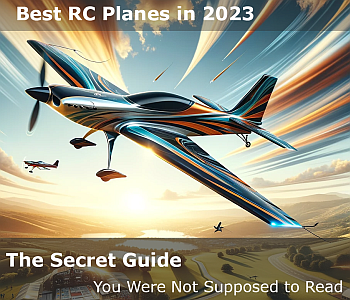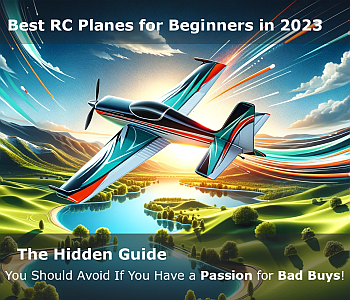Uncover the secrets to picking the perfect wings for your airborne adventures! Dive into our comprehensive guide and soar the skies with the RC plane of your dreams. No more second-guessing, no more buyer’s remorse. Your journey towards unbridled aerial ecstasy begins here!
Embarking on the journey of RC aviation is not just about buying an RC plane that catches your eye; it’s about finding a companion that resonates with your aviation aspirations. Whether soaring high in the tranquil skies or executing adrenaline-rushing aerobatics, the right RC plane amplifies every experience.
Before plunging into a purchase, comparing RC planes is your roadmap to making a well-informed decision. You can delve here into the best RC planes and unearth the best beginner RC plane to suit your flying fervor if you are in a hurry. However, knowing the basics is the cornerstone of making a sage choice.
Let’s propel into the realm of RC planes by understanding their basic types and components in the next section, “Understanding the Basics”.
Understanding the Basics
Contents
RC planes, standing for radio-controlled planes, are miniature aircraft operated remotely by enthusiasts from the ground using a transmitter. The world of RC aviation offers a plethora of aircraft types, each catering to different skill levels and preferences.
- Types of RC Planes:
- Trainers: These are ideal for beginners due to their high-wing design which provides inherent stability.
- Sport Planes: A step up from trainers, sport planes are versatile and capable of basic aerobatics.
- Aerobatic (3D) Planes: Built for advanced aerobatics, these planes are for skilled pilots.
- Warbirds: These are scale models of military aircraft, providing a sense of realism.
- Jets: High-speed and sleek, jets offer an adrenaline rush for experienced pilots.
- Gliders: Utilizing lift from slopes or thermals, gliders offer a serene flying experience.
Grasping the basic types of RC planes lays a solid foundation for you to delve deeper into the aesthetics and functionalities, which will be examined in the upcoming section on Design. This understanding will also aid you in appreciating the blend of artistry and engineering that goes into creating these captivating miniature aircraft.
Design
When stepping into the realm of RC aviation, the design of the aircraft is more than just a visual appeal; it’s about marrying aesthetics with functionality. The design encompasses the color scheme, shape, and the overall structure which, in turn, plays a pivotal role in the aerodynamic efficiency of the plane. A well-designed RC plane not only captures attention but also provides a smooth flight experience, minimizing drag and optimizing lift. It’s the balance between eye-catching aesthetics and aerodynamic efficiency that makes an RC plane truly stand out.
Moreover, the ergonomics of the design facilitate ease of handling and control, making your flight experience more enjoyable and less of a chore. A good design will have a comfortable grip, accessible controls, and a layout that is intuitive to navigate. It’s not just about how the RC plane looks, but how it feels in your hands and responds in the air.
As you delve deeper into the world of RC planes, you’ll realize that a well-thought-out design is a stepping stone to exploring advanced features that enhance your flight experience. Now, speaking of advanced features, let’s transition into the next crucial aspect of RC planes – the Technology.
Technology
In the realm of RC planes, technological advancements have significantly elevated the flying experience. At the heart of these marvels are the control systems, which have evolved from basic manual operations to sophisticated, computerized setups, offering pilots precise control over their aircraft. Technologies such as GPS, auto-stabilization, and telemetry now grace many models, providing real-time data, aiding in navigation, and ensuring a stable flight even in turbulent conditions.
Moreover, modern RC planes often come with advanced transmitters that offer multiple channels, allowing for intricate control over various flight aspects including the throttle, ailerons, elevators, and rudders. The integration of digital displays in transmitters provides a wealth of information at a glance, making it easier for pilots to monitor the vital statistics of their aircraft.
Furthermore, the advent of FPV (First Person View) technology has revolutionized the way pilots interact with their RC planes. By donning a pair of FPV goggles or via a screen on the transmitter, pilots can now see exactly what their aircraft sees, in real-time, providing an immersive flying experience that was once the domain of dreams.
As we transition from exploring the core technological aspects, the capability to perform aerobatics naturally emerges as a point of interest. The seamless blend of technology not only augments the basic flying experience but paves the way for exhilarating aerobatic endeavors, which we will delve into in the following section, “Aerobatic Capabilities”.
Aerobatic Capabilities
The allure of flying RC planes often extends beyond simple flight; aerobatics is where many enthusiasts find their thrill. When comparing RC planes based on their aerobatic capabilities, consider the design and the control system. A well-balanced design with a symmetrical wing, a powerful engine, and a responsive control system are the key ingredients for performing loops, rolls, and other aerobatic maneuvers. Planes labeled as 3D or aerobatic usually possess these traits.
Highly-rated aerobatic RC planes often have advanced control systems with high-quality servos and responsive receivers, ensuring precise control during high-energy maneuvers. The aerobatic charm is not just in the flight but in mastering the control that propels the plane through the sky in a dance defying gravity.
Now that we’ve explored the exhilarating world of aerobatics, let’s dive deeper into the general flight performance attributes, which also significantly contribute to the overall flying experience.
Flight Performance
In this section, we’ll explore three crucial aspects: Flight Time, Maneuverability, and Stability and Control. Understanding these elements will significantly bolster your ability to compare RC planes astutely.
Flight Time
The duration an RC plane can stay airborne is influenced by multiple variables:
- Battery Capacity: A prime determinant, the battery’s capacity dictates how long your RC plane can keep buzzing in the skies.
- Weight of the Plane: Heavier planes demand more power to stay aloft, hence draining the battery faster.
- Weather Conditions: Favorable weather can extend flight times while adverse conditions like wind or rain can curtail it123.
Maneuverability
Maneuverability is the RC plane’s ability to change direction, pitch, or altitude. Here are pivotal factors affecting it:
- Center of Gravity (CG): A well-balanced CG ensures smoother, more precise turns, loops, rolls, and other aerobatic maneuvers.
- Weight and Size of the Plane: Larger, heavier planes may have reduced maneuverability.
- Design of the Plane: The design, including the wingspan, aileron size, and other aerodynamic features, plays a key role in how maneuverable the plane is4567.
Stability and Control
Stability and control are quintessential for a good flying experience. Here’s what impacts these aspects:
- Aerodynamic Stability: Inherent stability designed into the plane by the creator across three axes: roll, pitch, and yaw.
- Static and Dynamic Stability: Refers to the aircraft’s initial response and ability to damp out oscillations post-disturbance, respectively.
- Control Surfaces: Ailerons, elevators, and rudders are crucial for control. Their size, design, and effectiveness are paramount for stable flight.
- Gyro Stabilization: Gyros can help in maintaining stability, especially useful for beginners or in windy conditions.
- Weight Distribution: An even distribution of weight within the fuselage helps prevent dynamic instability.
- Center of Gravity: It’s crucial that the aircraft’s Center of Gravity is accurately located to ensure stable and controllable flight8910.
With a solid grasp of these factors, you’ll be better equipped to judge the flight performance of different RC planes. Now, let’s glide smoothly into our next section, “Material Quality,” where we’ll examine how the build material influences the durability and overall performance of your RC plane.
Material Quality
In the realm of RC planes, the material quality significantly impacts both the performance and longevity of the aircraft. Common materials include balsa wood, foam, and composite materials.
Balsa Wood: Renowned for its light weight and structural integrity, balsa wood is a classic choice. It offers a fine balance between weight and strength, ideal for various flying styles.
Foam: Typically used in beginner and intermediate planes, foam is lightweight and resilient, making it forgiving during rough landings. There are different types of foam, like EPO and EPP, each with unique properties.
Composite Materials: A blend of materials like fiberglass, carbon fiber, or Kevlar, composite materials are known for their strength and durability while maintaining a light weight.
The material you choose will hinge on your flying ambitions and the level of realism you seek in your RC plane. A thorough understanding of material quality lays a solid foundation for your next consideration: the durability of RC planes, a facet that delves into the robustness, longevity, and maintenance requirements of these captivating miniature aircraft.
Durability
Durability is a paramount factor when comparing RC planes, especially for hobbyists who seek a lasting companion for their airborne adventures. The robustness of an RC plane is largely determined by its material composition. High-quality materials like carbon fiber or balsa wood tend to offer greater resilience against crashes and rough landings compared to cheaper alternatives like plastic.
Longevity goes hand-in-hand with robustness but also depends on the maintenance regimen. Regular checks, timely repairs, and proper storage significantly extend an RC plane’s life span, ensuring it remains airworthy for years.
Maintenance requirements vary; simpler models require less upkeep than their more complex counterparts. A plane with fewer electronic components or a solid one-piece wing design is easier to maintain.
The balance between durability and maintenance defines a plane’s true worth, and understanding this balance is essential. As we glide into the next section, we’ll discuss how assessing the Value for Money can further inform your purchasing decision, ensuring you get the most bang for your buck in the long run.
Value for Money
When it comes to comparing RC planes, gauging the value for money is crucial. This criterion is about balancing the scale between the price you pay and the features you receive. High-quality materials, advanced technology, and superior aerobatic capabilities often come at a premium. However, not all expensive RC planes guarantee superior performance, nor do all budget-friendly options fall short on quality.
Analyze the price in relation to the RC plane’s design, technology, flight performance, material quality, and durability. Look for planes that offer a good blend of these attributes without breaking the bank. A higher price tag might be justified if it translates to longer flight times, better aerobatic capabilities, or more sophisticated technology. Conversely, budget-friendly options might surprise you with their robust design and satisfactory performance.
Comparing RC planes based on value for money requires a discerning eye and a clear understanding of what each plane offers. It’s not merely about the cheapest or the most expensive; it’s about getting the most bang for your buck.
As you sift through the price and value, it’s also wise to delve into the brand’s reputation and what other hobbyists have to say about their experiences. Let’s transition into evaluating the credibility of brands and the authenticity of reviews in the next section.
Brand Reputation and Reviews
In the world of RC aviation, a brand’s reputation can be a beacon of trust. Renowned brands often have a legacy of quality, innovation, and customer satisfaction. Investigate a brand’s history, read testimonials, and look for awards or recognitions they might have received. Likewise, authentic reviews provide real-world insights into an RC plane’s performance and durability. Seek reviews on reputable hobbyist forums, and look for detailed user experiences, preferably with photos or videos.
As you delve into brand reputations and reviews, you’re gathering valuable information. Now, it’s time to take a closer look at how different RC planes stack up against each other. In the next section, “Comparative Analysis,” we will introduce tools and methods to compare RC planes systematically, aiding you in making an informed decision.
Comparative Analysis
Before diving into the world of RC aviation, equipping yourself with a robust comparative analysis toolkit is crucial. This endeavor begins by familiarizing oneself with online platforms that offer side-by-side comparisons of various RC plane models. Websites like HobbyKing and Horizon Hobby provide detailed specifications, reviews, and sometimes even comparison tools to aid in your analysis.
Next, crafting a comparison checklist is a wise step. This checklist should include criteria such as Design, Technology, Aerobatic Capabilities, Flight Time, Material Quality, Value for Money, and Durability. By systematically evaluating different models against this checklist, you’re not only ensuring a thorough analysis but also making the process replicable for future comparisons.
Having a well-structured comparative analysis in place will not only guide you towards making an informed decision but also prepare you for the financial commitment that follows. Speaking of financial commitments, let’s segue into discussing the importance of budgeting, as well as the support and warranties that accompany your RC plane purchase in the next section, “Price and After-Sale Support.”
Price and After-Sale Support
Investing in an RC plane is akin to embarking on an exhilarating journey into the realm of aerodynamics. However, ensuring that this endeavor doesn’t burn a hole in your pocket is crucial. Establishing a reasonable budget beforehand provides a financial blueprint, aiding in narrowing down choices. When dissecting the price, juxtapose the features, performance, and brand reputation to ascertain the value proposition.
Beyond the initial purchase, delve into the after-sale landscape. A robust support system and a comprehensive warranty are your safeguards against unforeseen hiccups. They epitomize the brand’s confidence in its creations and its commitment to customer satisfaction. Exploring forums and reviews can shed light on the support efficiency and warranty claims process of various brands.
Moreover, consider the availability of spare parts and the community’s sentiment towards the brand’s customer service. These factors significantly cushion your investment, ensuring that help is at hand when you encounter a rough patch in your RC aviation journey.
As we glide towards the conclusion, let’s encapsulate the crucial insights garnered, aiding you in making an informed decision for an unregrettable purchase.
Conclusion
Embarking on the journey of RC flying is an exhilarating venture, and the first step is selecting the right plane. By meticulously examining the design, technology, aerobatic capabilities, flight time, material quality, durability, and value for money, you pave the way for a satisfying and rewarding hobby experience. Remember, the essence of making an informed decision lies in thorough comparison. As you venture forth, may the skies be ever in your favor, and your chosen RC plane be the companion that propels your passion for aerial adventure to new horizons.




